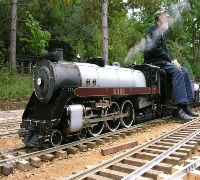St. Croix Railroad, Hudson Wisconsin
(715) 386-1871
This site copyright 2011 by the SCRR, Inc.
Contact the Webmaster with comments or suggestions.
Page updated 2/15/11
History

Copyright © 1997-2003 SCRR Inc.
The following article was published September 1996 as
part of the SCRR 25th Anniversary celebrations
(with a few minor updates applied subsequently)
The St. Croix Railroad - 25 Years in the Making
Donald O. Akins, Past President of the St. Croix Railroad
The old adage, "It seems like only yesterday" certainly rings true for those who were around twenty five years ago for the beginning of the St. Croix Railroad. What exists today was not in anyone's mind back then. Not even those with the wildest of imaginations. The St. Croix Railroad truly evolved with good ideas built on some basic ground rules. Rules like: different gauge tracks will be on their own separate right-of-way; in any one direction the ruling grade will not exceed one percent; no tracks would cross at grade level other than in the yards or station; the minimum radius for curves would be 60 feet for 1" and 90 feet for 1½” tracks; all tracks, bridges, trackside structures and trains operating on the Railroad will be made to look as close to scale as possible.
The St. Croix Railroad would not exist at all if it had not been for the enormous generosity of Bob Ahrens, who provided the land. Also, the Railroad would not exist if it were not for the countless members and individuals who have given so many hours of "back breaking" work at the track site. We often joke that the railroad is the St. Croix Railroad on run days and called the St. Croix Health Spa on the Saturday work days. Most workers have also said that none of us would ever do this kind of work for a living because it is too hard, but we will all do it for nothing and call it a hobby! Also, to the members who work at home during the week making detailed drawings; obtaining supplies; sawing ties; making track panels; planning the Saturday work, etc., etc. The list goes on and on.
The origins of the St. Croix Railroad were a group of 18 people who previously had been members of the "Southern Minnesota Live Steamers This group was headed by Richard M. Winkle of Rochester, Minnesota. They would meet monthly at different members homes and show railroad movies and slides. Once or twice a summer they would have a live steam "Meet" at Albert T. O'Neil's home in Lake City, Minnesota. It was at one of these "Meets" in 1970, after looking at pictures of the track near Portland, Oregon, that it was decided to build a track near the Twin Cities. Bob Ahrens stepped forward and offered the land. In the fall of 1970, we looked at the potential site and it was depressing! The area was so overgrown with trees, brush and weeds that we wondered if this was the right place. It also was too hilly. We joked that what we thought we really wanted was an abandoned football field or some area that was relatively flat. But nothing else was available so we proceeded.
Our first effort was to bring in a transit/level and put in some elevation stakes to see if it was at all possible to lay some flat track. Thus, in the next summer of 1971, we decided to give it a try and construction began. The St. Croix Railroad was born!
The next effort was to blaze a trail for a road to get into the site. The road started in the southeast corner next to an existing farm and headed west along the south boundary and up and over the hill which now has the 1 1/2" tunnels through it. Next was the clearing of brush for the infield parking lot, which included sumac, cedar trees, woods and other brush... growth so tall you could hardly see where you were.
The first of any rails to be laid was for the elevated track. The loop around totaled about 1,200 feet, including the yard lead and had four rails on it for ¼”, ½”, ¾” and 1" equipment. This required two years to construct. With the exception of new trusses under the rails this line is exactly as it was when finished in 1972.
Before the elevated track was finished work began on the 1" ground level track. It was a 1,050 foot oval with a 75' passing track directly opposite the station at what is now known as Malfunction Junction. One and a half years were required to build this line and it was ready for our Fall Meet in 1973.
Next to be started was the 1½" ground level track. The first phase was a 900 foot circle which went around the infield parking lot and steaming bay (this portion was subsequently removed in 1987 during other construction work). The second phase of the 1½” track was basically built around the perimeter of our 9½ acre site. Construction started in 1974 and was finished in 1978. The line featured a 51 foot tunnel, a 125 foot wood trestle, and totaled 1,849 feet around.
Work started in 1977 on the second phase of the 1" line extension. The track climbed a 0.7% grade up to an 81 foot tunnel before dropping back down over a 128 foot wood bent trestle. This extension made the 1" line 2,185 feet long and was finished in September, 1980. We now had a "figure 8" track plan.
In 1983 it was decided to add further to the 1" line by circling Akinback hill and reaching the Summit. This track was finished with a golden spike ceremony on September 4, 1988. The main line now totaled 4,041 feet. Since then, only bridge replacements and new sidings have been added to the 1" line.
The third and last phase of track construction on the 1 1/2" line started in 1987 with the installation of a 125 foot tunnel under the 1" track. The line now resembles an "inside figure 8" and totals 3,600 feet of main line. This extension was completed in 1992. Since then only sidings have been added.
With tracks being laid throughout the 1970's and 1980's, and now totaling about two and a half miles, the other effort in the 1980's and early 1990's was all the other associated facilities. We built two pole barns, a storage garage, a coal shed, an outdoor toilet, a train storage building, a passenger loading station, a picnic table area, a steaming bay and poured countless yards of concrete.
We truly have built one of the finest miniature railroads anywhere in the country. What started out as seemingly insurmountable obstacles because of the trees, bush and hills, turned out to be a natural blessing as we simply built the tracks around or tunneled through the hills, bridged over or ran through the valleys, and left the terrain in virtually the same shape as we found it. The Railroad exhibits all the natural obstacles found on real railroads except for water. But, who knows, maybe someday we will even have a small lake to bridge over!
The St. Croix Railroad has now been 25 years in the making. Is it finished? Only the future will tell. The active members of today will all say there is still much to be done. Like building scale track-side structures, adding miniature towns and industries along the right-of-ways... No, we are not finished! The list can go on and on as long as you are willing to dream and make the effort to make it come true.
Who knows what our 50th Anniversary will be like. For those who have worked so hard in building the first 25 years, we can only hope we might still be around for the 50th and that the second 25 years will be as productive and rewarding as the first.
Current membership in the St. Croix Railroad now totals approximately 160 members. Of the original 18 charter members, five are still around. They are: Don Akins, Jim Dietel, Bob Duwe, Jim Machacek and Dick Winkle. We like to think that former charter members Bob Ahrens, Hugh Brakke, Bob Darr, Bob Ferns, Bill Goesch, Milo Grelson, Vern Hankins, Fred Hanvey, Dick Johnson, Chad Larson, Pershing Scott, Iver Sigveland and Don Strom continue to watch our progress from above.
